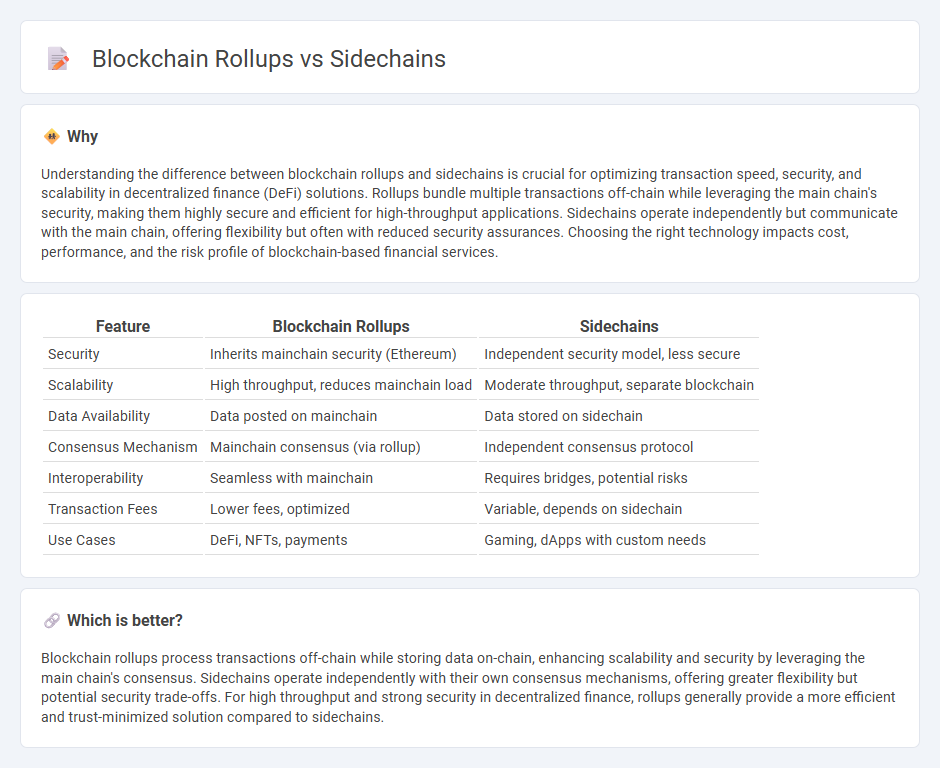
Blockchain rollups enhance scalability by processing transactions off-chain while maintaining security through the main chain, reducing congestion and lowering fees. Sidechains operate independently with their own consensus mechanisms, allowing diverse applications but requiring trust in separate networks. Explore the differences and benefits of rollups and sidechains to optimize your blockchain finance strategy.
Why it is important
Understanding the difference between blockchain rollups and sidechains is crucial for optimizing transaction speed, security, and scalability in decentralized finance (DeFi) solutions. Rollups bundle multiple transactions off-chain while leveraging the main chain's security, making them highly secure and efficient for high-throughput applications. Sidechains operate independently but communicate with the main chain, offering flexibility but often with reduced security assurances. Choosing the right technology impacts cost, performance, and the risk profile of blockchain-based financial services.
Comparison Table
| Feature | Blockchain Rollups | Sidechains |
|---|---|---|
| Security | Inherits mainchain security (Ethereum) | Independent security model, less secure |
| Scalability | High throughput, reduces mainchain load | Moderate throughput, separate blockchain |
| Data Availability | Data posted on mainchain | Data stored on sidechain |
| Consensus Mechanism | Mainchain consensus (via rollup) | Independent consensus protocol |
| Interoperability | Seamless with mainchain | Requires bridges, potential risks |
| Transaction Fees | Lower fees, optimized | Variable, depends on sidechain |
| Use Cases | DeFi, NFTs, payments | Gaming, dApps with custom needs |
Which is better?
Blockchain rollups process transactions off-chain while storing data on-chain, enhancing scalability and security by leveraging the main chain's consensus. Sidechains operate independently with their own consensus mechanisms, offering greater flexibility but potential security trade-offs. For high throughput and strong security in decentralized finance, rollups generally provide a more efficient and trust-minimized solution compared to sidechains.
Connection
Blockchain rollups and sidechains both enhance scalability by processing transactions off the main Ethereum chain, reducing congestion and lowering fees. Rollups bundle multiple transactions into a single proof posted on the main chain, while sidechains operate as independent blockchains linked through bridges to the main network. This interconnected approach optimizes transaction throughput and security in decentralized finance (DeFi) ecosystems.
Key Terms
Scalability
Sidechains operate independently from the main blockchain, enabling offloading of transactions to enhance scalability while maintaining their own consensus mechanisms. Blockchain rollups process multiple transactions off-chain and bundle them into a single transaction submitted on the main chain, significantly reducing congestion and increasing throughput. Explore further to understand how these solutions uniquely address scalability challenges in blockchain networks.
Security
Sidechains operate independently with their own consensus mechanisms, which may introduce security risks if validators are compromised, while blockchain rollups inherit the security guarantees of the main chain by executing transactions off-chain but posting data on-chain. Rollups, including Optimistic and ZK-rollups, enhance security by relying on the robust consensus of Layer 1 blockchains like Ethereum, minimizing trust assumptions. Explore detailed comparisons to understand how these technologies balance scalability and security for your blockchain applications.
Interoperability
Sidechains operate as independent blockchains connected to the main chain, enabling cross-chain asset transfers and enhanced interoperability through separate consensus mechanisms. Blockchain rollups consolidate multiple transactions off-chain and submit compressed data to the main chain, improving scalability while maintaining security and benefiting from the main blockchain's consensus. Discover how these technologies differ in advancing interoperability and scalability in decentralized networks.
Source and External Links
What are sidechains? - Coinbase - Sidechains are independent blockchain networks linked to a parent blockchain via a two-way peg that enables transfer of assets, aiming to boost scalability, interoperability, and enhanced privacy/security through their own consensus protocols.
An Introduction to Sidechains - CoinDesk - Sidechains connect to a main blockchain with a two-way peg, allowing secure asset transfers and enabling larger transaction capacity and improved privacy via separate consensus mechanisms.
What Is a Sidechain? - Ledger - Sidechains are separate blockchains linked to a mainnet through a two-way bridge, reducing congestion on major blockchains by providing alternate transaction routes for improved scalability.
 dowidth.com
dowidth.com